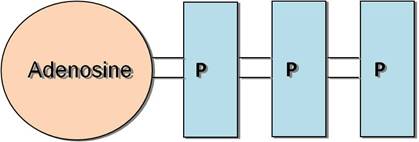Energy systems
For our bodies to function, even at rest, we need energy. This energy is derived from the food we eat, which is used to make ATP (Adenosine Tri-phosphate).
ATP is the body's energy currency. It consists of one adenosine molecule attached to three phosphate molecules. Energy is released when the bond between the 2nd and 3rd phosphate is broken, leaving ADP (Adenosine di-phosphate) and a free phosphate:
ATP molecule
The breakdown of ATP into ADP, a free phosphate and energy
There is only a limited supply (about 2 seconds) of ATP in the muscles; once it has been used it needs to be resynthesised so that it can be used again. To resynthesise ATP energy is needed. This energy is derived from the breakdown of the food we eat and used to rejoin ADP (Adenosine diphosphate) and the free phosphate.
The resynthsis of ATP from ADP, a free phosphate and energy
The body has three energy-producing systems which are used to breakdown the food we eat and resynthesise ATP. These are:
- ATP-PC system
- Lactic acid
- Aerobic system



